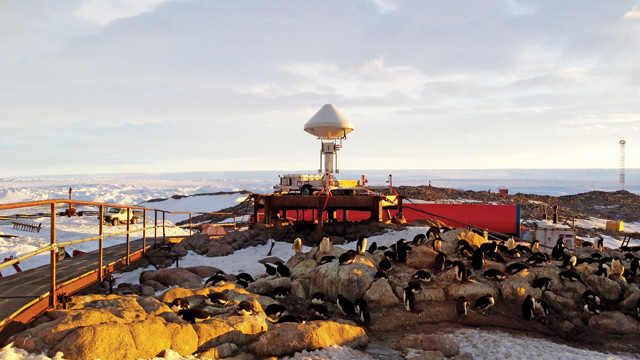
by Timothy Oleson Thursday, December 14, 2017

Using data from the Dumont d'Urville research station on the coast of East Antarctica, researchers determined that dry katabatic winds over Antarctica substantially decrease the amount of snow that reaches the continent's icy surface. Credit: Environmental Remote Sensing Laboratory, Swiss Federal Institute of Technology (LTE/EPFL).
From Antarctica to the Arctic; from polar caps, permafrost and glaciers to ocean-rafted sea ice; and from burly bears to cold-loving microbes, fascinating science is found in every nook and crevasse of Earth’s cryosphere, and new findings are announced often. Here are a few of the latest updates.
Glaciers cover about 100,000 square kilometers in the high mountains of Asia (HMA) — including the Himalaya, Karakoram, Pamir and other ranges, as well as the Tibetan Plateau — constituting the highest concentration of glacial ice on Earth aside from the polar regions. Many previous studies of glacial change in the HMA — which is known to be highly variable from place to place, with most glaciers shrinking while some are growing — have looked at relatively localized areas, leaving scientists to extrapolate trends over large unstudied areas. This has led to a range of estimates of glacial change in the HMA and complicated projections of future change. In a new study in Nature Geoscience, researchers used satellite imagery collected by the Terra satellite to investigate glacial mass balance across about 92 percent of the glacier-covered area in the HMA between 2000 and 2016. Fanny Brun of Grenoble Alpes University in France and colleagues reported that, over that period, the total mass of glacial ice in the HMA decreased by about 16 gigatons per year — a lower rate of loss than previously estimated. In agreement with past studies, however, they found that rates varied substantially among different mountain ranges — from an annual loss of 4 gigatons of ice to an annual gain of 1.4 gigatons — as well as from glacier to glacier within ranges.
Katabatic winds that blow dense, dry air from Antarctica’s interior toward its coasts decrease the amount of precipitation that reaches the continent’s glacial surface, according to a new study in Proceedings of the National Academy of Sciences. The winds create a dry layer of air in the lower atmosphere in which, researchers suggest, precipitation falling from above sublimates before reaching the ground. “This layer is in a blind zone for satellites … which explains why this phenomenon had not been detected by satellites,” said study co-author Alexis Berne of the Swiss Federal Institute of Technology, in a statement. Based on radar data and precipitation measurements collected at the Dumont d’Urville research station on the coast of East Antarctica between November 2015 and January 2016, combined with atmospheric models, Berne and his colleagues estimated that this sublimation reduces total snowfall over the continent by 17 percent, and over the East Antarctic coast by up to 35 percent. The findings of the study suggest “that snowfall sublimation in a warming climate may counterbalance the expected increase of precipitation,” the team wrote.
Red pigment-producing algae cast shades of pink over icefields and snowfields in some areas during the summer melt season, decreasing the albedo of the ice and snow and contributing to melting and runoff. In a new study, scientists quantified the effects of such algae on an icefield on Alaska’s Kenai Peninsula. In spring and summer 2014, Gerard Ganey of Alaska Pacific University and colleagues added doses of water, or water and nutrients, over small, algae-bearing patches of the 1,890-square-kilometer Harding Icefield, roughly 700 square kilometers of which is considered “red-snow area.” Compared to control patches in which nothing was added, algae populations grew by half on average when water alone was added and four-fold when a nutrient solution was added — findings that confirmed that growth of the algae is limited by availability of both liquid water and nutrients, the team reported in Nature Geoscience. By simultaneously measuring melting in each patch during the experiments, as well as how much light was reflected from the ice surface of each patch (called the spectral reflectance), the team correlated algal abundances with icemelt and decreases in albedo. They then used satellite measurements of spectral reflectance over the Harding Icefield to estimate that algae were responsible for 17 percent of the total melting in the red-snow area. The team noted that the effect of microbes, like algae, on ice- and snowmelt “may match that of nonliving particulates [like soot and dust] at high latitudes,” and that projected increases in meltwater and nutrient availability “will certainly increase the glacier microbiome’s impact on polar albedo.”
© 2008-2021. All rights reserved. Any copying, redistribution or retransmission of any of the contents of this service without the expressed written permission of the American Geosciences Institute is expressly prohibited. Click here for all copyright requests.